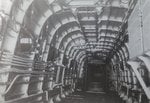Glider
Major
As a transport the Sterling was pretty good and thinking about it a good contender for the aircraft in a secondary role thread.
edit - additional information
On the 5th August three Sterling's from 620 Sqd joined the USAAF base at Harrington to assist with the dropping of people taking part in a Carpet Bagger operation. The original plan was to use six Liberators but changed when it was realised that three Sterling's could do the job.
They caused quite a stir as it was the first time they had seen a Sterling close up and the whole thing was filmed by one Captain John Ford. So somewhere there is an interesting film to be dug up
edit - additional information
On the 5th August three Sterling's from 620 Sqd joined the USAAF base at Harrington to assist with the dropping of people taking part in a Carpet Bagger operation. The original plan was to use six Liberators but changed when it was realised that three Sterling's could do the job.
They caused quite a stir as it was the first time they had seen a Sterling close up and the whole thing was filmed by one Captain John Ford. So somewhere there is an interesting film to be dug up
Last edited:

